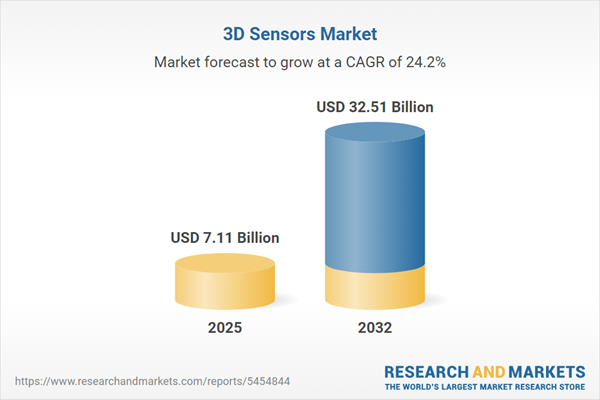Speak directly to the analyst to clarify any post sales queries you may have.
The three-dimensional sensors market is reshaping global industries, serving as a critical enabler for advancements across automotive, healthcare, industrial automation, and consumer electronics. As this market evolves, decision-makers must understand the complex interplay of technology developments, shifting trade policies, and application-driven segmentation defining future opportunities and risks.
Market Snapshot: Growth Momentum and Trajectory
The 3D Sensors Market grew from USD 5.73 billion in 2024 to USD 7.11 billion in 2025. It is expected to continue expanding at a CAGR of 24.22%, reaching USD 32.51 billion by 2032. Demand is accelerating as precise, spatially aware sensor technologies become foundational across advanced manufacturing, connected vehicles, healthcare diagnostics, and entertainment systems. Product innovation and integration strategies are intensifying regional competition and catalyzing disruption in traditional value chains.
Scope & Segmentation: Market Coverage and Key Segments
The report provides in-depth segmentation and analysis, offering strategic insight into every major dimension driving the three-dimensional sensors market:
- Sensor Types: Acoustic imaging, laser triangulation, photogrammetry, structured light (dot pattern, grid pattern), and time-of-flight (flash, phase shift).
- Technologies: CCD (frame transfer, interline transfer), CMOS (active and passive pixel sensors), and quantum image sensors.
- Applications: Advanced driver assistance, infotainment, machine vision, robotics, medical imaging, patient monitoring, and virtual reality.
- End Users: Aerospace and defense, automotive (commercial, passenger), consumer electronics, healthcare (clinics, hospitals), manufacturing (automotive OEM, electronics OEM).
- Form Factors: Embedded modules (in smartphones, tablets, wearables), modular architectures, standalone sensor units.
- Depth Range: Short, medium, long, ultra-long range operation categories for diverse field-of-view and precision requirements.
- Regional Markets: Americas (United States, Canada, Latin America), Europe, Middle East & Africa (Germany, France, United Kingdom, regional clusters), and Asia-Pacific (China, India, Japan, South Korea, others).
- Company Profiles: Analysis of key players including STMicroelectronics, Infineon, Texas Instruments, onsemi, Sony, ams OSRAM, Analog Devices, Panasonic, Teledyne Technologies, and Himax Technologies.
Key Takeaways: Strategic Market Insights
- Three-dimensional sensing is moving from specialized uses to widespread adoption, with miniaturization and integration enabling new consumer and industrial applications.
- Technological leadership hinges on innovations in quantum imaging, hybrid CCD-CMOS designs, and advances in artificial intelligence and sensor fusion analytics.
- Industry collaborations—between electronics brands, automotive OEMs, and specialized startups—are accelerating development of modular and scalable solutions for multiple end markets.
- Segmented product offerings are aligned to specific market needs, from healthcare diagnostics to robust industrial automation environments and immersive virtual reality experiences.
- Regional policies, ecosystem maturity, and end-user readiness are shaping distinct market strategies, particularly in Asia-Pacific and North America.
Tariff Impact: Navigating Supply Chain and Cost Structures
Recent United States tariff policies have increased costs for imported imaging modules and semiconductor components, compelling stakeholders to restructure supply chains and explore nearshoring or regional partnerships. Value engineering and co-investments in domestic manufacturing have become essential for maintaining competitiveness while managing evolving cost structures and risk exposure.
Methodology & Data Sources
This analysis integrates secondary research from technical publications and market filings, supplemented by primary interviews with industry leaders and domain experts. Both qualitative perspectives and quantitative modeling verified findings, with cross-functional panels ensuring the reliability of segmentation criteria and competitive positioning.
Three-Dimensional Sensors Market: Why This Report Matters
- Enables decision-makers to align product and investment strategies with evolving technology, application, and regional trends.
- Provides segmentation detail and competitive intelligence needed to assess new market opportunities and mitigate regulatory or supply chain risks.
Conclusion
The three-dimensional sensor industry stands at a critical transformation point, offering growth potential for organizations that adopt modular, adaptive strategies, leverage collaboration, and invest in next-generation sensor technologies. Informed decisions grounded in this research will support sustained competitiveness as the market landscape evolves.
Additional Product Information:
- Purchase of this report includes 1 year online access with quarterly updates.
- This report can be updated on request. Please contact our Customer Experience team using the Ask a Question widget on our website.
Table of Contents
3. Executive Summary
4. Market Overview
7. Cumulative Impact of Artificial Intelligence 2025
Companies Mentioned
The companies profiled in this 3D Sensors market report include:- STMicroelectronics N.V.
- Infineon Technologies AG
- Texas Instruments Incorporated
- onsemi Corporation
- Sony Group Corporation
- ams OSRAM AG
- Analog Devices, Inc.
- Panasonic Corporation
- Teledyne Technologies, Inc.
- Himax Technologies, Inc.
Table Information
| Report Attribute | Details |
|---|---|
| No. of Pages | 192 |
| Published | October 2025 |
| Forecast Period | 2025 - 2032 |
| Estimated Market Value ( USD | $ 7.11 Billion |
| Forecasted Market Value ( USD | $ 32.51 Billion |
| Compound Annual Growth Rate | 24.2% |
| Regions Covered | Global |
| No. of Companies Mentioned | 11 |









